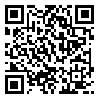Volume 3, Issue 5 (2018)
JCSFA 2018, 3(5): 77-95 |
Back to browse issues page
Abstract: (8036 Views)
The present study, aiming to discover the relation between social variable of gender and the language characteristics of women writers, seeks to investigate gender markers in two novels named “Aashaqoni” (I Love Myself) by Sanaa Shaalan (The best Jordanian feminine novel in 2013) and “Parandeye Man” (My bird) by Fariba Wafi (The best Persian feminine novel in 2002) based on Lakoff pattern using a descriptive-analytical method. The results show that nearly one fourth of the words in “Aashaqoni” have feminine language characteristics, and women language in over a quarter of the words in “Parandeye Man” indicates a feminine narrator. Since the writers of both novels are women writing about women, the frequency of feminine jargon is high in the novels. Employing exact and specific delineation and using diverse color terms are other feminine language features of these novels. Due to low confidence resulting from living in a masculine world, women in both novels use adverbs indicating doubt, uncertainty, and intensity more and employ a polite language in their conversations through avoiding taboo words and using indirect requests that indicates the language structures of cautious and base narrators.
Article Type: Original Research |
Received: 2018/11/5 | Accepted: 2019/07/11 | Published: 2018/08/15
Received: 2018/11/5 | Accepted: 2019/07/11 | Published: 2018/08/15
| Rights and permissions | |
 |
This work is licensed under a Creative Commons Attribution-NonCommercial 4.0 International License. |

